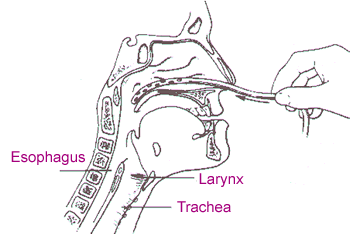Suction is used to 'suck up' the 'gunk' (secretions) sitting on your bronchial tree for patients that can't clear their own airway for themselves.
You can suction via...
- Trachy (tracheostomy)
- Endotracheal tube
- Oral airway
- Nasal airway (e.g. Nasopharangeal)
Indications (when to think about using it!)
- Reduced cough effort or inability to cough to clear airway
Contradications (when to NOT use it!)
- Frank haemoptysis (expectoration of blood only)
- Severe bronchospasm
- Undrained pneumothorax
- Compromised CVS
- Raised ICP
- Fractured skull/facial bones
Hazards of Suctioning
Suction is an invasive procedure and causes irritation to the delicate lining of the airways (tracheal/bronchial epithelium). This adverse effect is minimised by using an appropriate size catheter (simple calucation to figure this out: double size of trachy and minus 2 e.g. size 8 trachy = 16 - 2 = size 14 catheter). Also make sure to use correct pressures e.g. around 25.
If ventilation is interupted (e.g. too big a tube, suctioning for too long etc) a reflex bronchospasm may occur. Pre and post Rx O2 can help reduce any hypoxia.
- Cardiac arrthymias/bradycardia
Suctioning can cause a vasovagal reflex (a GI tract reflex that controls contraction of gastrointestinal muscles in response to stretching of the tract by food, controlled by the stretch/osmo & chemoreceptors of the dorsal vagal complex). This can lead to arrthymias so check with medics first.
Suction raises ICP so if someone already has elevated levels (e.g. TBI, SAH etc) then be very cautious and seek medical opinion prior to attempting suction.



Thrombocytopenia - reduced platelet (thrombocyte) count. Normal range for platelets is (150–400)×109 per litre. Check platelet count before performing suction. If it's too low, damage to tracheal/bronchial lining can bleed excessively.
ReplyDelete